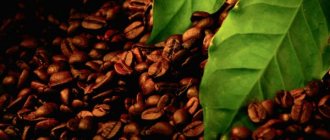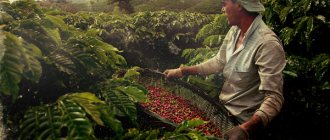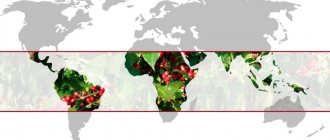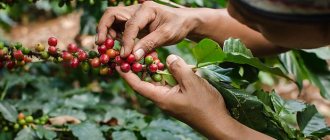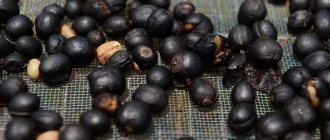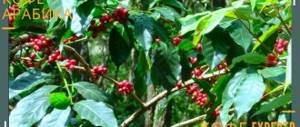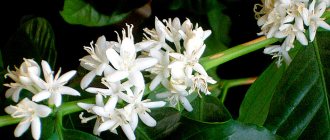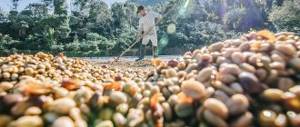What's the first thing that comes to your mind when talking about coffee? Brazil - you will say and you will be absolutely right. Indeed, today this country ranks first in the world in the cultivation and production of coffee. Every third serving of coffee is due to the labor of the Latin American population. Although Central Africa is recognized as the ancestor of this drink. It was there, on the swampy shores of Lake Chad, that a bush of this plant was found. There is a lot of controversy about the tastes and aromas of brasil coffee, now we will figure out what Brazilian coffee is.
History of Brazilian coffee
Now ask any schoolchild what he knows about coffee, and you will get an instant answer: Brazil is the country of coffee. But we will try to dispel doubts about the origin of this plant.
Few people know that the coffee bush was brought to Brazil illegally, through intrigue, love and seduction of women. At the beginning of the eighteenth century, diplomat Francisco de Melo Palheta used all his charm to carry out the order of his government and bring a coffee tree to the territory of his country at all costs, and the governor’s wife could not resist Francisco’s charms, subsequently giving him the coveted bush .
So in Brazil they began to grow coffee for their own needs, and from the mid-eighteenth century the real coffee boom of Brazil began, exporting coffee to America and Europe. People quickly liked the beans, which had invigorating properties, and coffee production in Brazil gained unprecedented momentum. In the mid-twentieth century, Brazilian coffee accounted for almost 40 percent of total world production.
Due to the increase in industrial production volumes, workers were required. People began to migrate from all over the world to provide inexpensive labor, and the beginning of the twentieth century marked the second coffee boom in Brazil. It is known under the slogan Coffee with milk. It was on these two products that the country's economic growth was based.
During this period, the country processed an incredible amount of coffee, the market was oversaturated, the government was forced to increase the price of Brazilian coffee and banned exports to other countries until the price returned to its previous positions.
By 1920, Brazil had become virtually the only coffee-producing country, accounting for eighty percent of the world's coffee industry. But in the early fifties, other countries began to produce coffee no worse than Brazil, and foreign coffee gradually began to displace the main monopolist.
Tastes in coffee have changed, and a softer taste and refined aroma have become valued. Brazilian coffee, produced in huge quantities, began to suffer from competition. Other states demanded that export standards be reduced. Now Latin Americans are investing heavily in coffee production, which allows them not to lose their position and remain a leader in the coffee industry.
Coffee production and Brazilian recipe
After the abolition of slavery, African slaves were replaced by foreign migrants, since the Brazilians themselves could not cope with the enormous amount of work on the plantations. It was as centers of coffee production that the cities of Sao Paulo and Rio de Janeiro developed, attracting Europeans who wanted to make money or get rich quickly.
By the second half of the 20th century, export earnings from Brazilian coffee beans accounted for more than half of the country's profits, making the coffee industry the leading industry in the state. The main exporter of coffee from Brazil is the USA.
Grateful for the culture, Brazilians erected a monument to the coffee tree in Sao Paulo. There are also monuments to coffee beans in Costa Rica and Thailand.
Why did Brazil become a leader in coffee production?
- The products are of high quality; Brazilian coffee is not just a name, it is a brand that is obliged to maintain its reputation.
- The Association of Coffee Producers controls the harvested crop and the finished product; the standard of packaging and storage conditions are strictly monitored.
- The plantations are located on the plains, which makes it possible to grow coffee with a smooth, strong taste without the sour taste found in high-mountain varieties of other countries.
- Much of the coffee in Brazil is dry processed to achieve extra density. This quality allows it to be successfully used to create espresso mixtures.
- Affordable and meets all the needs of coffee drink lovers.
Brazilians themselves literally cannot live without coffee. They drink several cups a day, albeit small ones of 100-150 ml. The classic Brazilian drink is prepared using a filter: paper, fabric or titanium. The first two are much cheaper, but the paper filter retains some of the aroma, so the fabric filter is preferred by housewives. The recipe is simple:
- The filter is placed above the dishes by weight or using a special plastic holder-nozzle.
- 1-2 teaspoons of ground coffee are poured into it.
- Water that is just starting to boil is poured into the filter in a gentle stream (necessarily filtered or mineral water without gas).
Sugar can be added to the water before pouring into the filter, or after, into each cup and cinnamon and milk to taste.
Method of growing and processing raw materials
There are no high mountainous regions in Brazil, so coffee grows on plantations, the taste of which is soft and strong. It is generally accepted that the higher the fruits grow, the richer their taste, but despite this opinion, Brazil does not give up its leadership in the production of coffee beans. The advantage of Brazilian coffee is the lack of sourness, which not everyone likes, due to the area where it grows.
In this country, in most cases, the dry harvesting method is used, leaving the grains to dry in the open air for several weeks. Dry grains turn brown. Then the peeling procedure takes place.
Then they are sifted through several sieves of different diameters, distributing the grains by size. A small amount of beans are processed wet, which significantly increases the cost of the finished coffee beans.
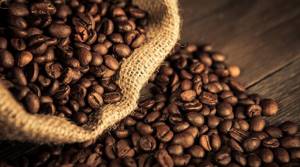
Coffee connoisseurs do not particularly appreciate the taste of Brazilian coffee, since there is no zest in it, it is a simple, tasty and strong drink that can simply invigorate, but they do not get much pleasure from the drink.
The main products produced here are Arabica and Robusta. Robusta is ideal for making espresso, the most common and frequently ordered coffee in the world, the export of Robusta supplies one in three cups of the population.
In order to give the coffee different shades, Brazilian coffee beans are mixed with spices. But before you buy a package of coffee, carefully read the ingredients.
It is unlikely that any ordinary coffee lover will be able to distinguish the type of coffee in a drink; only true gourmets can do this, so Brazilian coffee is perfect for an every day morning ritual.
Coffee production in Brazil now
Currently, in six states (in addition to the above, these are Bahia and Rondonia) there are more than 220,000 coffee farms. 80% of the product grown in Brazil is Arabica, the remaining 20% is Robusta.
Be sure to read: What is green coffee and is it really effective for weight loss?
The country leads the world's top four in terms of green (unroasted) coffee production. Next come Vietnam, Indonesia and Colombia. Brazil also supplies instant coffee.
The grains grown in this country have three characteristics;
- Atypical growth altitude, which ranges from 400 to 1200 meters above sea level. This is not always enough to produce a high-quality drink.
- Coffee grows on the plateau. The plantations do not have a significant difference in elevation. As a result, all the berries ripen at the same time, which allows the use of mechanical harvesting. This significantly reduces the cost of products, but negatively affects its quality.
- Solar growing system. Coffee trees grow in the open sun, which, on the one hand, increases the number of beans, but, on the other, depletes the soil. Farmers are forced to apply large amounts of fertilizer.
The grains are also processed mainly using the dry method, since rain is unlikely during the harvest period. The collected grains are placed in the sun and kept for 12-14 days, stirring occasionally. During this time, they acquire a brown color and undergo internal fermentation.
Then the top layer is peeled off, the grains are sorted and sent for roasting. This procedure adds velvety and aroma to the taste.
70-80% of all grains grown in Brazil are processed using the dry method. The rest of the crop is processed using the wet method, which is much more expensive.
It should be noted that in Brazil, cinnamon or cloves are often added during roasting, which makes the taste of the drink more rich and individual. But sometimes this procedure is caused by the need to drown out the specific iodine taste of grains, which they receive due to the high content of this element in the soil.
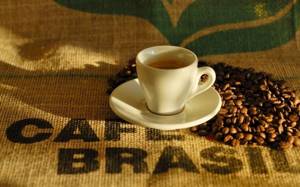
The taste of Brazilian coffee
The popularity of Brasilia coffee is limitless, but the taste and aroma remain mediocre. It does not represent any sophistication, however, it is perfect for everyday use. Despite the simplicity of taste, Brazilian coffee is extremely popular. It is used to make such a simple, but so often ordered espresso.
The famous Santos coffee is considered the most popular; it is quite good in both taste and smell. This brand is exported to many countries and it is believed that the Santos coffee brand is the best Brazilian coffee. Another type of coffee is Bourbon Santos, which has clove notes in its taste. It is available in instant and grain form.
Instant coffee is made from failed beans that are not suitable for sale as beans. But for lovers of a very quick morning cup of coffee, instant bourbon Santos is in great demand not only all over the world, but also in the Russian Federation.

Variety of varieties
You can simply love coffee without thinking about the name and origin, or you can search for and try different unique varieties. About half of Brazil's coffee beans end up in a market called Santos (named after the port from which it is exported). Santos is a coffee blend with the best flavor and aroma characteristics.
- Bourbon Santos. The most famous Brazilian product, the standard of taste. Grown in the vicinity of Sao Paulo and in the south of the country. It is this variety that is famous all over the world and retains its admirers with an unchanged, truly coffee taste.
- Minas. Produced in the state of Minas Gerais, it has the same historical roots as Santos, but due to the iodine soils on which it grows, it has an unusual, even repulsive, medicinal taste. When mixed with other varieties, it adds refined notes to the drink.
- Victoria and Rio, closely related varieties, come from the states of Rio de Janeiro and Espiritu, and their smell is also strongly medicinal. They say you can get used to it, but almost no varieties are imported to Europe. But in the East they are highly revered for their deep and rich taste.
- Bahia. This is a variety that grows in the plateau region of the state of the same name. Coffee trees can withstand light frost. Cooking requires certain skills and full adherence to technology, only then can you get a unique tart taste with bitterness.
- Parana, a variety from the state of Parana. By itself it has a great taste, but is inferior in characteristics to Santos and Minas. Due to its low cost, it is often added to various types of instant coffee.
- Maragogyp. The plant with the largest grains. The variety arose by chance as a result of natural hybridization. The drink made from roasted beans is tasty, but similar to other types of coffee, although it has a slightly richer and more balanced taste.
Coffee imported from Brazil has been pleasing coffee lovers with its taste for more than a century. Neither Colombia nor Ethiopia can seriously compete with it. After all, in every sip there is a little sun, carnival and warm ocean...
photo: depositphotos.com/sidneydealmeida
Types and varieties of Brazilian coffee
There are not so many types of coffee around the world, so coffee plantations in Brazil are planted with Arabica and Robusta, which are familiar to us, in a ratio of 80:20. The influence of the first violin of the coffee business is so great that if the harvest decreases, the cost of coffee around the world will increase, despite the yield in other countries.
Kinds
Espresso is mainly made from Brazilian coffee. The types of coffee are affected by the area of cultivation, Arabica varieties, the size and color of the fruit itself, and the parameters of the richness of taste and aroma.
Brazilian coffee, the best varieties
The diversity of Brazilian coffee varieties does not in any way affect the sustainable cultivation of only two types - Brazilian Arabica and Robusta, and the more capricious Arabica is grown by a significant margin more than the primitive Robusta. For Arabica beans, elevated areas with a dry climate are preferred so that the beans are harder.
Coffee beans contain a small amount of caffeine, but they have a unique aroma that robusta is incapable of. Robusta grows in low bushes in low-lying areas of the country, but its beans contain more caffeine, making it ideal for an invigorating morning drink.
Quality control is carried out at every stage of harvesting and processing, right up to packaging. Since Brazil has many competitors, and quite justified ones, Brazilian manufacturers have no right to make mistakes in quality. And every year the quality of products is valued more than quantity.
It is not possible to single out the best type of coffee, since experts have divided their opinions, but we will try to present the line of the most popular varieties as follows.
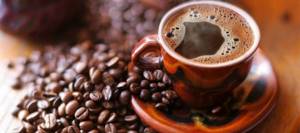
- Brazil Santos coffee is the most popular variety of Brazilian coffee. It consists of several varieties, combining all the delicacy and delicacy of the drink. In regular sales you can find Santos coffee of the fourth grade. The first grade is more the exception than the rule.
- Maragogyp coffee is a combination variety with large beans.
- Brazil Iponema Rubi - This coffee grows in the highest mountainous areas and is popular in Latin American countries.
- Brazil yellow bourbon is a gourmet find, produced in its pure form.
- Brazil mogiana coffee is a type of specialized variety that has a fine line between sweetness and sourness.
Coffee Santos
This variety ranks first in popularity due to its taste and affordable price. It is a descendant of the old Arabica and grows mainly in the south.
Variety Minas
It has a specific smell due to the soil on which it grows, it is used in blends, it is not considered as a single variety, and it has a tart taste.

Maragogyp
It is distinguished by its large fruit size. Ambiguous expert opinion. But he did not leave anyone indifferent. It has a rather rough taste.
Variety Paransky
In the line of varieties of Parano coffee (and there are seven of them), the fifth is the most sold. This variety is not as high quality as the previous ones, but it is much cheaper. Paransky is named after the name of the port. Many varieties are named after the area in which they are grown, and the Paranan variety is no exception. Brazil even named the coffee brand brazil, after the entire country.
Brazil: record holder for coffee production
Coffee is as integral a part of Brazil as traditional Brazilian carnivals. For about 150 years, Brazilian coffee has been a national treasure, and Brazil is the undisputed world leader in its production. Today in Brazil there are about 4,000,000 coffee trees, and coffee plantations are located almost throughout the country (with the exception of 4 out of 21 states), which provides up to 35% of world coffee production.

It is important to note that Brazil is not the birthplace of the coffee tree, and coffee beans were only introduced and first planted in the Brazilian state of Pará in 1727. Initially, coffee plantations were concentrated in the state of Sao Paulo, which today remains one of the main places for coffee production. Over time, the coffee industry moved primarily to the state of Minas Gerais, where most of Brazil's coffee is now produced. It is also grown in the states of Parano, Bahia, Espirito Santo and Rondonia. On the territory of the last two there are plantations of Robusta coffee trees. Robusta makes up 20% of Brazil's coffee production, while the remaining 80% is Arabica. Both grow mainly on plateaus or hilly landscapes. The exception is the Sera do Caparao massif, where coffee is grown at an altitude of 1,500 meters.
Earlier we said that the higher the height of the coffee trees, the higher the quality of the coffee. Keeping this fact in mind, Brazilian coffee cannot be called the best in the world. However, it is possible to identify varieties that have received wide recognition and high praise from consumers. For example, the Bourbon Santos variety is the highest quality Brazilian coffee with a mild aroma, good richness and moderate acidity. Or coffee from the Cerrado region of the same name - a well-balanced coffee with a creamy taste and a chocolate-nut, even slightly caramel, aroma.
In Brazil you can also find exotic coffee, one of which is Jacu coffee. The principle of obtaining beans is the same as in the case of the famous Kopi Luwak coffee, only here the berries are digested not by animals (musangs), but by birds of the parrot family - grays. Grays are very selective and eat only the ripest and highest quality berries, subjecting them to harsh natural selection and thereby providing potentially the best beans for a limited batch of elite coffee.
The most common Brazilian coffee is Santos, named after the Brazilian port of Santos, from which coffee beans have been exported for a long time. At the same time, Santos is not an ordinary coffee variety; it is a mixture consisting of beans of 8 separate varieties.

The regions of Brazil have unique weather conditions and climate that allow coffee cherries to ripen at approximately the same time, making the harvest easier. For this reason, Brazilians have the opportunity to harvest by stripping, using a mechanical method. The manual method of harvesting in Brazil is unprofitable, because... Picking on such a scale as Brazilian coffee plantations entails too great a financial cost. By the way, the average size of a coffee plantation there ranges from 10 to 50 hectares.
According to experts, in the 2011-2012 season, about 50,000,000 bags of coffee beans were collected in Brazil (1 bag = 60 kg), of which more than 33,000,000 were exported. This indicates not only the great economic importance of coffee production for the country, but also that domestic coffee consumption in Brazil is very high. According to the International Coffee Organization (ICO), Brazil ranks second in coffee consumption after the United States. Russia also entered the list of the most active coffee consumers, taking 7th position after Germany, Japan, France and Italy.
How to prepare Brazilian coffee
For coffee lovers, there is not much difference in the words Brazil and coffee. The country has the right to be considered one of the most coffee-drinking countries in the world. Brazilians brew coffee simply and tastefully. Here are some examples of how ordinary people brew coffee:
Take a paper or fabric filter and add a couple of tablespoons of ground coffee, pour in very hot water and wait a few minutes. Add the necessary spices, sugar, cream or milk. The procedure is over and you can enjoy.
Another method of preparing traditional Brazilian coffee takes a little longer, but the result is worth the time spent:
Place a few pieces of dark chocolate in a cup. Pour espresso. Then add hot milk, beat in a blender until foam forms and decorate the drink with cream.
But first of all, you need to know what you cannot do without making a delicious cup of coffee.
- select coffee beans of exceptional quality, they must be properly roasted and stored properly
- use only freshly ground, medium-ground grains
- After adding spices or other additives, it is recommended to pass the drink through a filter
In fact, Brazilians have many recipes for brewing coffee, but the most popular are the following:
- With chocolate and cream : put 50 grams of dark chocolate in 100 grams of espresso, add sugar according to your preference, pour in 200 grams of milk, then beat the mixture well and pour into tall glasses, garnish with whipped cream and grated chocolate chips.
- With cocoa and ice cream: boil cocoa, add sugar and a little salt (salt breaks up the sweet taste), whisk the cocoa thoroughly and pour into a cup. Pour 100 grams of espresso into the cocoa in a small stream, add ice cream. All! Enjoy.
The fastest recipe
To quickly make coffee you don’t need any special tricks. All you need is a multi-use or disposable filter, freshly ground high-quality coffee and water. The water should first boil, but do not rush to pour boiling water. Pour a few tablespoons of ground grains into the filter and fill with slightly cooled water. If you add your favorite spices, don’t be lazy and strain the drink. Add sugar and cream to taste and bask in the aroma and taste.
Famous brands of Brazilian coffee
Volcanica Coffee, Ferris Coffee, Fresh Roasted Coffee. The last brand on the list is unroasted coffee.

Interesting Facts
- Brazil is not only the world's coffee tycoon, but also the world's consumer. It competes with Ethiopia.
- The worst Brazilian coffee beans are processed into instant coffee. Brazil exports instant coffee in the amount of ten to twenty percent.
- Frosts occur in Brazil. This affects the yield.
- There are still slave-like working conditions on the plantations of this country.
- Some Brazilian coffee may smell fruity due to the way it is grown.
- The older the tree, the cheaper the coffee collected from it costs.
- In Santos Yellow Bourbon, the berries are yellow rather than the usual red.
- Santos packages feature a photograph of the coffee bean in its original size.
- With the wet harvesting method, grains are more expensive.
- Farmers sell not only bean coffee, but also ground coffee. Brazil adds all kinds of spices to its ground coffee to give its coffee a more refined aroma.
Features of coffee from Brazil
Each country has its own climate and soil composition, so grains of the same variety grown in different conditions have different tastes. What are the hallmarks of real Brazilian coffee?
Growing and processing conditions
There are no high mountainous regions in this country. Coffee plantations here are located on small hills or even on plains. Therefore, the taste of most varieties of Brazilian Arabica is strong and smooth, without characteristic sourness.
Planters here obtain coffee beans using a mostly dry processing method. It has been known since ancient times and is not distinguished by any sophistication.
The collected fruits are simply laid out in an even carpet under the sun's rays. Stir them periodically to ensure even drying. After two weeks the process is usually completed. Instead of reddish wet berries, you get brownish, dried fruits. The top shell is removed by peeling, and the grains are sorted by size, sifting through special sieves. As a rule, this procedure is done manually.
More than 2/3 of all coffee sold in the world is dry processed. Wet processing of grains is more expensive and requires more modern equipment and large amounts of clean, running water.
The taste of Brazilian coffee
Coffee from Brazil does not have an exquisite taste, and real gourmets prefer completely different varieties. It is believed that grains from this country have rustic taste characteristics, without deep nuances. Traditional dry processing of grains provides an even denser taste. Therefore, Brazilian coffee does not often receive the attention of tasters and connoisseurs. But it is ideal for preparing an invigorating morning espresso, with its rich taste and nutty crema. Brazilians themselves also prefer to drink espresso or its local varieties.
Unlike Colombia, where only Arabica is grown, Brazil has not ignored Robusta, which accounts for about 15-17% of total exports. In addition, this type is included in most espresso blends, which European cafes and restaurants so readily buy.
One more nuance for those who buy grains ready for grinding. Brazilian roasters often add cinnamon or cloves to deepen the flavor and sometimes offset the distinctive aroma that characterizes many of the varieties grown in the country's iodine-rich soils.
The Brazilian Coffee Association carefully controls the quality of its products, marking them with its own brand. Therefore, many people enjoy real coffee from Brazil as an everyday option. After all, how many of us, ordinary consumers, are such sophisticated gourmets who can distinguish a simply good type of coffee from an excellent one, especially in the morning before work?
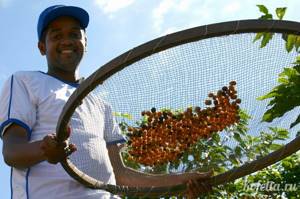
Brief history
The first coffee in Brazil appeared at the beginning of the 18th century. The plantations grew quickly because African slaves were actively recruited to work. Unprecedented harvests led to the opening of the first coffee factories. Another hundred years later, European emigrants contributed to the unprecedented prosperity of the industry.
At the beginning of the 20th century everything fell into disrepair. But already in the 60s, Brazil became the leader in coffee production in the world. Today the country accounts for 35% of product exports on the planet. And coffee plantations occupy 1/5 of the total area of Brazil.
Coffee plantations in Brazil
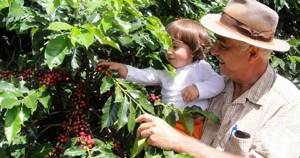
Brazil is the largest coffee producer in the world, its plantations occupy 5th of all agricultural land. The most valuable variety, called Arabica, is grown here. It is known for its perfect taste and amazing aroma. It is believed that every third cup of this invigorating drink is made from raw materials grown in this country.
World leader
For 150 years, Brazil has been a leader in coffee production. About 2.5 million tons of raw materials are produced here annually, with 80% being Arabica and 20% being Robusta. It should be said that 75% of the plantations belong to four Brazilian companies. 1.8 million tons of coffee beans are exported here. This country ranks 2nd in the world market and is second only to the United States.
The area of coffee plantations in Brazil is 2.2 million hectares, with about 6 billion trees growing on their territory. There are 300 thousand farms in the country, which are located in 2 thousand cities. Most of them are located in states such as Parana, Minas Gerais and Sao Paulo. Natural conditions have a significant impact on the harvest; due to drought and frost, yields often fall and prices rise.
Locals are focused on producing small lots and prioritize quality over quantity. Due to the fact that coffee plantations are located in different regions of Brazil, which differ in topography, microclimate and production methods, the country offers tourists a delicious assortment of aromas and tastes.

Excursion into history
Currently, no one knows exactly when the first tree was planted here, but all residents can tell a legend about how it appeared in the state. Approximately 300 years ago, officer Francisco de Melo Palheta traveled to French Guinea to resolve a dispute regarding the borders of the states. He was also tasked with getting a coffee bean from the plantation, which the young man took out in a bouquet. This is how the coffee tree was brought to Brazil.
Growing this plant quickly became popular as it was profitable. Europeans flocked here wanting to make money, which contributed to the emergence of farming plantations and the development of large cities. Over a long period of time, Brazil has developed traditions of growing, assembling and processing grains, and the secret of production is a family heirloom and is passed on only to close relatives. Local residents love to drink coffee and rank 1st on the planet according to this indicator. On average, each Brazilian drinks 84 liters of this drink per year.

Production stages
Coffee berries grow on trees that need about 10 liters of water every day. The harvest is harvested from April to September, when the weather is cool and dry. The pickers pick only ripe fruits and put them in wide sieves, and they go to the plantations every day to get a high-quality and uniform product.
After this, the berries are washed and usually laid out in the sun in one layer, but they can also be dried in large barrels, which spin the proteins from the inside. The grains must be constantly stirred so that they do not rot. This process lasts from 2 to 3 weeks, after which the fruits are placed in a special machine, where they are peeled. The coffee is then bagged and sent to a warehouse where it is roasted and packaged.
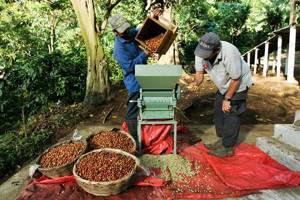
Where are the largest coffee plantations in Brazil?
Currently, trees grow in almost all states of the country, but the largest areas are located in the southern part of the country. It is dominated by a mild subtropical climate and mountainous landscape. The most famous coffee plantations are located in places in Brazil such as:
- Brazil Santos
is a port town where several varieties of coffee grow. They produce a high-quality product, distinguished by a mild taste with sourness and a delicate aroma. The Santos Grade branded coffee is produced here, the packaging of which must indicate the grain size and production method (wet or dry). - Minas Gerais
is the capital of the state where one of the types of Arabica grows - Bourbon. The drink made from such grains has an unusual medicinal taste, which not everyone likes. For this reason, these fruits are used as a mixture, which makes it possible to neutralize the “pharmacy” fragrance and obtain a rich color, pleasant taste and moderate strength. - Mantiqueira
is a mountain range where coffee is grown on 70 thousand hectares at an altitude of 900-1400 m. This coffee region is famous for its fertile red soils and unique microclimate. Tree planting began here about 100 years ago, with many farmers first growing sugar cane and then retraining. Today, individual banana palms or corn are often found on plantations. About 30 types of Arabica grow in Mantiqueira, among which is the elite variety Geisha or Gesha, imported from Ethiopia. - Espirito Santo
– in terms of production volumes, the city is in the leading lists of the country. Robusta has been grown here since the 1920s. In 2015, local breeders, after 30 years of research, were able to develop a new variety of coffee that is more resistant to high temperatures and drought, while the growing season occurs much faster, new seedlings appear in 3.5 years. Thanks to the work of scientists, production volumes increased significantly and improved the economic situation of the entire state. - Sao Paulo
– coffee cultivation began here in the second half of the 19th century. Vast plantations attracted millions of immigrants. It has turned from a small coastal settlement into a large industrial center. The region has a mild subtropical climate and mountainous terrain, which has a beneficial effect on plantations. The process of growing and harvesting remains the same for a long time. - Bahia
– coffee cultivation began here in the second half of the 20th century. Currently, the region is known for high-quality grain and high technology. The state often experiences dry winters and warm summers, which contribute to abundant harvests. The plantations cover an area of 150,555 hectares, with 75% of the crops being Arabica. Farmers prefer the Kathua variety. Robusta trees began to be planted in the 80s. XX century and today the land covers an area of 49.8 hectares. - Rondônia
is a state of Brazil characterized by low altitudes, a humid climate and high temperatures. Farmers are attracted here by the fertile red soil, which produces a rich harvest. For many families, coffee plantations are the only source of income. Robusta is mainly grown here; the total area of land is 83,339 hectares. - Parana
is a unique coffee-producing region, which is the southernmost point in the world where such trees are grown. This area is known for its red soils and quite varied topography. The total area of plantations is 41,100 hectares. The local coffee variety is inferior in quality to Minas and Santos, so it is often used in instant drinks, where its shortcomings are almost invisible.

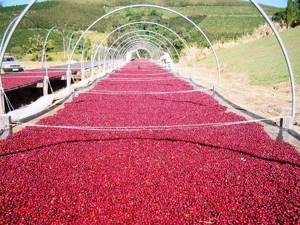
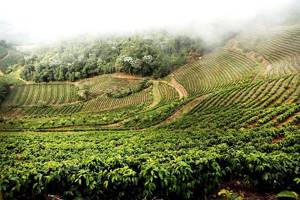


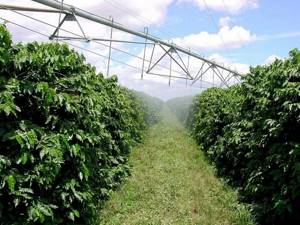
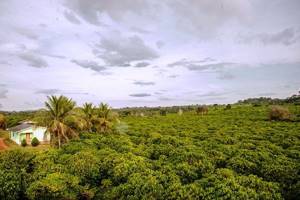
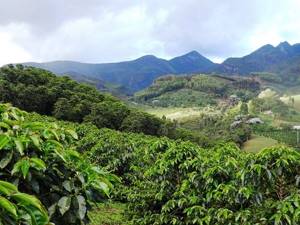
Product Features
It is believed that coffee trees should be grown on mountain slopes. However, the territory of Brazil boasts only small elevations. Therefore, plantations are established even on the plains. This feature is reflected in the soft taste of the final drink. Brazilian coffee does not have the bright acidity that many drinks from other countries have.
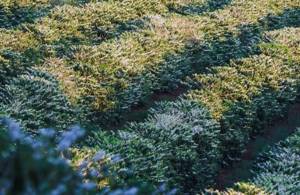
The final taste of the drink is influenced not only by the growing conditions of the grains, but also by subsequent processing. Before selling raw materials to other countries, Brazilians handle them very carefully. Here are 7 important factors:
- Growth conditions . Not only the choice of planting location affects, but also the care of coffee trees. It is important that Brazilians do not treat their plants with chemicals. Otherwise, the taste and benefits of coffee would be lost.
- Season selection . Coffee in Brazil is harvested during the sunny season: from mid-spring to early October. Therefore, grains and trees on plantations do not rot.
- Drying in the sun . After harvesting and first cleaning, some of the coffee in Brazil is dried in the open air for 2 weeks. They are constantly stirred so that the grains brown evenly.
- Wet processing . About 30% of the grains are sorted using filtered water. This is a complex and expensive cleaning method, so this coffee is valued even more.
- Peeling . After solar drying, the outer shell easily separates from the grain, so the process takes place without damaging the product.
- Sorting . Special equipment quickly separates “non-standard” grains from ideal grains.
- Storage . Brazilian coffee is stored in canvas bags. Be sure to use in cool, dry areas.
The quality of the product is monitored by the Brazilian Coffee Association. Earning its seal can only be achieved through strict adherence to standards.
It is not the sellers who do the roasting and grinding, but the buyers. These can be either Brazilian or foreign companies. They can either highlight and reveal the taste of local coffee, or ruin it.
Watch a short video with experts talking about how coffee is grown in Brazil. And what path does it take from a flower to a fragrant drink on your table?


